|
– Part 2: Technical specs and special features –
I'm never sure whether to cover each of the films in a set like this individually when it comes to the sound and vision specs, or whether to discuss them collectively. Here there are enough small differences between them to warrant the first of those two options. All of the titles here are framed in their original aspect ratios, which in the case of the first five films is 1.37:1, with Naked Alibi framed 1.85:1.
The Web has been transferred from a 2017 restoration from a 4K and looks really good here, with a nicely toned and punchy but not aggressive contrast range with solid black levels. Although it has been cleaned up, a few dust spots do remain, and just occasionally increase in frequency, but this is never distracting. As you would hope from a 4K scan, the detail is crisply rendered.
Larceny has also been sourced from a 2017 restoration from a 4K scan and boasts a robust contrast range and really solid black levels. Image detail is sharp at best, but does soften a little in some shots. Again, the image has been cleaned up but a few small dust spots remain.
Kiss the Blood Off My Hands has been sourced from a 2019 restoration from a 2K scan, and has a solid contrast range and lovely deep black levels. The image detail is good, but is a notch softer than the sharpness standard set by the previous two titles and has a more visible film grain. It does, however, have fewer remaining dust spots than either of those transfers.
Abandoned was sourced from a 2010 remaster and features a nicely balanced tonal range, with solid blacks and decent shadow detail, as well as crisp rendering of the picture detail. This is also the cleanest transfer so far, with very few visible dust spots.
Deported was transferred from a 2017 restoration from a 4K scan, and boasts a decent contrast range but picture sharpness that, while very good for the most part, does vary a little, sometimes on a shot-to-shot basis. Some small dust spots remain, and very occasionally a single frame of damage is briefly visible, but otherwise this is in good shape.
Naked Alibi has been sourced from a 2014 restoration from a 2K scan, and while the film grain is more visible here than on the other transfers, the tonal range is really nice, the black levels are solid, and the image detail is crisp. It's also almost completely clean of dust and damage.
All six films feature Linear PCM 1.0 mono soundtracks, and while there is an inevitable narrowness to the dynamic range on all six films, there is some minor variance in the audio quality. There is a very slight background hiss on The Web, and a minor fluff underscoring some of the dialogue on Deported, but the tracks are otherwise clean and free of damage. The dialogue is generally very clear, though does have a little less breadth on Abandoned, while as the most recent film, the sound is a little livelier all round on Naked Alibi.
Optional English subtitles for the deaf and hearing impaired are available for all films, including the short films in the special features.
THE WEB
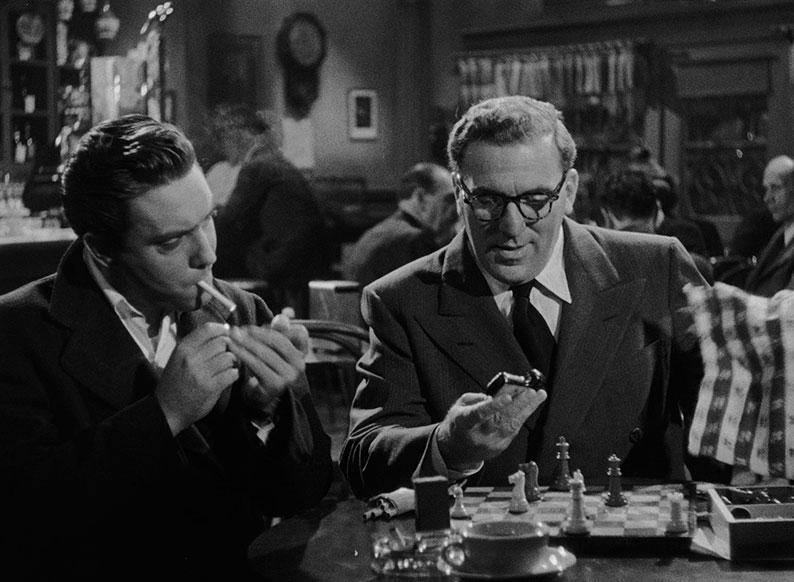
Audio Commentary by David Del Valle
Film historian David Del Valle starts off by dedicating his commentary to the actor John Abbot, who plays Charles Murdock in the film and with whom Del Valle was friends for the last five years of his life. No surprise, then, that Abbot gets some coverage here, but so do all of the lead actors, screenwriters William Bowers and Bertram Millhauser, and director Michael Gordon. Del Valle provides useful information on the gun control laws in New York at the time the film was made and set, reveals some of the earlier titles for the film, speculates on why the film was omitted from The Encyclopaedia of Film Noir, and notes that Howland Chamberlain's portrayal of author James Timothy Nolan is one of the earliest examples of an openly gay character in a mainstream American film.
Film Noir Festival Q&A with Victoria Price (29:47)
Hosted by writer and film historian Alan K. Rode, this on-stage interview with Vincent Price's daughter Victoria was conducted at the Film Noir Festival in Palm Springs on 11 May 2018. Price talks about her father's lifelong love of art, buying his first artwork at the age of 12, the amazing parties he and her mother used to throw, his befriending of a young art enthusiast named Dennis Hopper, his theatre work and first movie contract, how his enthusiasm for cooking led to a best-selling cookbook, and more. She's very honest about the good and bad aspects of her father's relationship with actor Coral Browne, recalls being invited to Jane Russell's house and meeting Robert Mitchum, and claims that the best thing about all of the celebrities she knew growing up is the stories they had to tell.
Lux Radio Theatre: 'The Web' (52:38)
First broadcast on 27 September 1947, this faithful Lux Radio Theatre adaptation – which also stars Ella Raines, Edmond O'Brien and Vincent Price – accelerates the pace by cutting chucks of dialogue, speeding up the delivery and eliminating pauses, but retains most of the key lines and follows the plot of the film to the letter. Aspects shown visually in the film are economically worked into the dialogue – "I have a gun in my hand," Martha Kroner tells Bob as he enters his apartment, something we can clearly see in the screen version. If you're going to adapt an 87 minute movie into a 50-minute radio play, this is the way to go. Pleasingly, all of the promos for the sponsor have been excised from this version, but the rehearsed end-of-play 'light-hearted' interaction between the host and the stars had me wincing.
Image Gallery
34 screens containing gorgeous looking monochrome promotional stills and a sprinkling of posters.
Skirmish on the Home Front (1944) (13:14)
Alan Ladd stars as Mr. Sensible to William Bendix's more spendthrift friend in this well-intentioned but unsubtle push to buy and hold onto government bonds during wartime rather than spending the cash on something like a new home. If you fritter your money away now, the film suggests, not only will you probably get ripped off, but it might even make you ill. If you hang onto the bonds, however, one day you'll be able to afford a glorious home full of gadgets that your wife will extoll the virtues of with all the sales glee of a shopping channel presenter. A rather staid presenter clearly explains the economics of this, but I'd love to know who he is telling this to – once he gets going her never looks at the camera, his roving gaze suggesting there are a whole group of invisible listeners in the studio. Answers on a 1940s postcard, please.
LARCENY
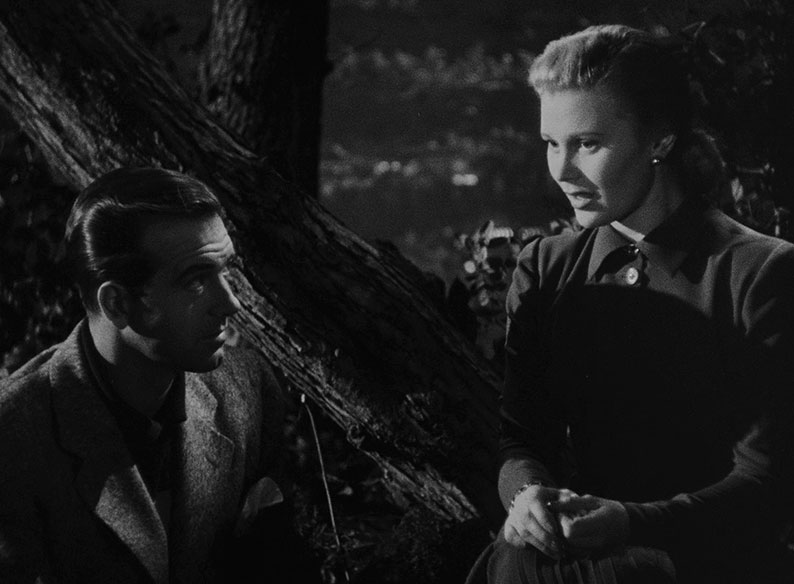
Audio Commentary with Eloise Ross
Australian academic and curator Eloise Ross provides a detailed appreciation and examination of Larceny, praising the screenplay and dialogue, and exploring the work of director George Sherman, cinematographer Irving Glassberg, several of the actors, and especially costume designer Orry-Kerry, whose work on the film she misses no opportunity to enthusiastically praise. She discusses the film's noir elements (including those that are atypical for the genre), comments on its portrayal of small town America, and even notes the role of the gas station in noir movies, an observation that immediately had me digging through my memories for further examples of that little trope. A solid supporting feature.
The Heel with Sex Appeal: Nick Pinkerton on Dan Duryea (29:01)
Film critic Nick Pinkerton kicks off this engaging and informative look at the life and work of actor Dan Duryea with a useful instruction on how his surname should be pronounced. I've always wondered. He traces his career from his first brush with acting at Cornell University, through his years as an ad man that ended with a nervous breakdown, to his return to the stage and the movie work this ultimately led to. Most of Duryea's key roles get at least a mention and sometimes more, as with his memorable introduction in Winchester '73, And yes, Larceny is briefly covered. Pinkerton confirms that Duryea was in person the complete opposite to his bad guy screen persona, and that the nastier his character, the more it seemed to appeal to his female fans, hence the title.
Image Gallery
26 screens of high quality promotional stills, including some posed portraits, and a couple of posters.
KISS THE BLOOD OFF MY HANDS
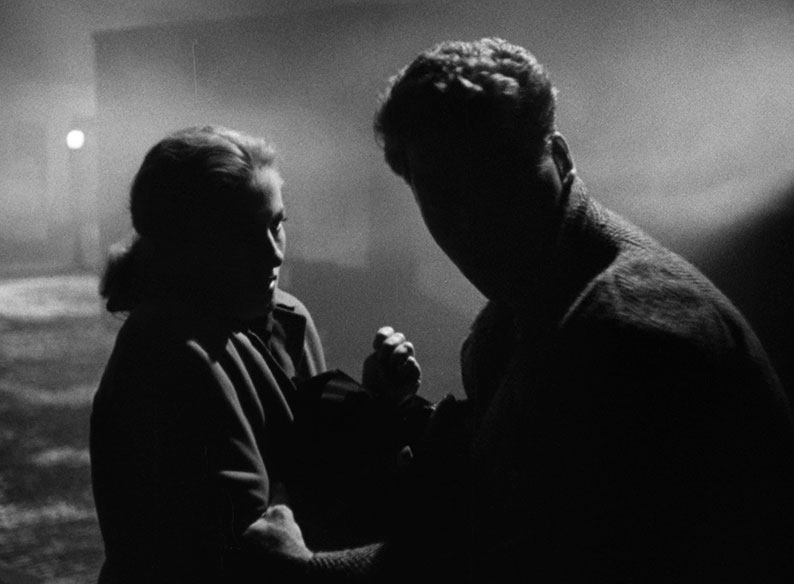
Audio Commentary with Josh Nelson
Film historian Josh Nelson kicks off by suggesting that Kiss the Blood of My Hands is "surely a contender for the greatest film title ever committed to celluloid, or at least the most lurid," and describes the film as a treasure trove of his cinematic interests. This is a fascinating commentary in which Nelson divides his time between the factual and the analytical, informing with the former and providing plenty of food for thought with the latter. Subjects covered include art directors Nathan Juran and Bernard Herzbrun, the differences between the film and Gerald Butler's source novel, the lead actors, director Norman Foster, cinematographer Russell Metty, the work of sound technicians Leslie I. Carey and Corson Jowett, and more. He discusses the expressionist effect of the lighting and set design, the wartime veteran as a symbol of America's dark psyche, the links to later Vietnam vet films like Taxi Driver, and the repeated use of the cage motif, as well as peppering his commentary with interesting and relevant quotes. An essential listen.
The John Player Lecture with Joan Fontaine (63:07)
Conducted by Martin Shawcross at the National Film Theatre in London on 4 November 1978, this interview with the then 61 year-old Joan Fontaine is an absolute delight, with the effervescent Fontaine in lively and sometimes even mischievous form throughout. She kicks off by revealing how much she hates watching herself on screen, and provides consistently entertaining responses to questions about key films in her career and working with a range of notable filmmakers and actors, including George Cukor, Alfred Hitchcock, Orson Welles, John Houseman, Harry Belafonte, and more. She's full of engaging tales and misses no opportunity to make fun of the jokey rivalry between herself and her older sister, Olivia de Havilland, who by using the family name first effectively forced Joan to pick another surname for her acting career. It's all enormous fun, with Fontaine's comical stories peppered with one of the dirtiest laughs I've heard in some while, and comments that suggest she's still having a whole load of fun. "Nobody's yet asked me to make a picture naked," she complains at one point, "and I'm hoping somebody will." My favourite comment comes during the audience questions when she points out one particular gentleman and says enthusiastically, "There's a handsome man down here and I'm dying to have him… (she's interrupted here)" before then telling the man in question, "Don't ask me anything, just meet me later."
Theatrical Trailer (1:36)
A functional trailer that gives a flavour of the main plot and describes it as "the story of a love that that no right to be" and contains what I'd class as a major spoiler, so save this one for later.
Image Gallery
37 screens containing promotional stills of varying quality, luminously coloured lobby cards, and four posters.
United Action Means Victory (1939) (36:11)
Ah, now you're talking. Presented by the International Union United Automobile Workers of America, this short film tells the story of the 1939 strike by the tool & die makers at General Motors, a crucial group of workers being paid pitifully low wages while the company basked in half-year profits of $100 million. Sound familiar? And try to imagine what that would be in today's money. An unashamedly propagandist piece that is fully justified in the face of the wall of pro-corporate propaganda being paid for by the company and spouted by the press of the day, it's the sort of thing that can't help but warm the heart of lifelong union members like myself. It also serves as a reminder for those smug twerps who claim not to see the point of unions that they probably only command the wage that they so because of the struggles of people like those featured in this film. Some aspects do feel a little trapped in time – the men go on strike and their concerned wives are eventually convinced to support them and join them on the picket lines – but others have a worryingly contemporary ring, including a police force that does the company's bidding and the company's attempt to ship in scab labour to undermine the strike. The soundtrack would make for an interesting album of pro-union songs, and the power of collective action is wonderfully illustrated when the farmer's union rolls up to supply food for the families of the striking workers, and the narrator states, "The farmer's union asks only to see an empty basket and a paid-up union card. That's the real spirit of Americanism." That, my friend, is solidarity.
ABANDONED
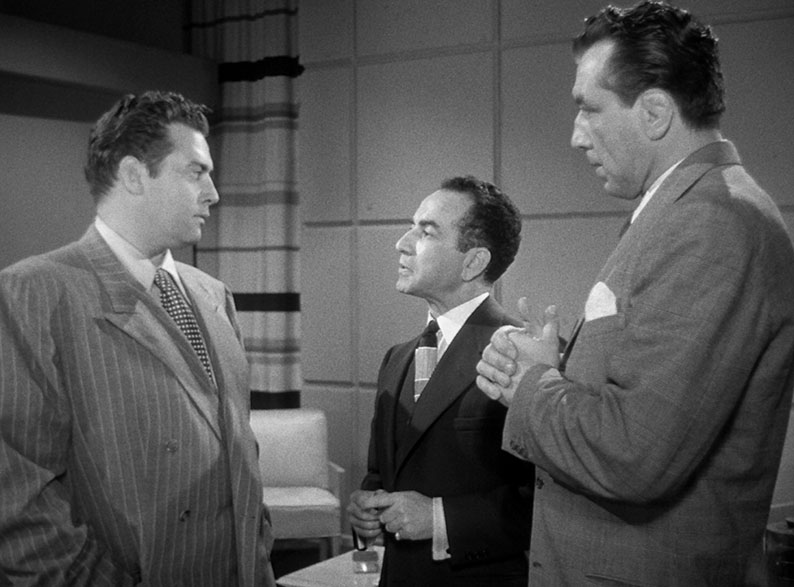
Audio Commentary with Kim Newman and Barry Forshaw
The ever-lively duo of Kim Newman and Barry Forshaw note from the start that Abandoned is "not quite a film noir," though Newman rather wonderfully remarks that noir is a genre that was "diagnosed rather than industrialised." I'd have given real money to have come up with that. As well as providing background information on the lead actors and some of the supporting cast, they deliver some entertaining analysis of individual scenes, characters and themes, echoing my own thoughts in places (damn them) and adding a few that had genuinely not occurred to me but were intriguing enough to have me rewatching the film with these points in mind.
Image Gallery
22 screens containing publicity photos, posters, and a single behind-the-scenes shot.
Easy to Get (1947) (21:27)
A War Department official training film, directed by Joseph M. Newman, designed to warn soldiers of the dangers of catching venereal diseases like syphilis or gonorrhoea. For a film made in America in 1947, it's remarkable for two reasons. The first is its primarily black cast, which includes addresses to camera by Olympic athlete Ralph Metcalfe and actor/singer Paul Robeson, suggesting that the film had a very particular target audience. The second is that because this was made by the War Department for viewing solely by enlisted men, it wasn't bound by the same censorship rules that applied to films for general public viewing. Thus the film doesn't talk about how to apply the contents of a prophylactic kit to your penis to prevent infection, it shows you the process in explicit detail. And if you've ever wondered what male genitalia might look like if the infection takes hold, well get ready to be shown this in unblinking close-up. Although warning of the dangers of unprotected sex, the film ultimately seems to be promoting complete abstinence as the only same solution, and paints a rather uncomfortable picture of all women as potential carriers of venereal disease. "You catch it only one way, from a woman," insists the narrator with a more than a whiff of disapproving disgust. "Doesn't matter if she's a high school girl or a gin joint girl. Inside her there may be sores, full of crawling little germs." Yikes.
DEPORTED
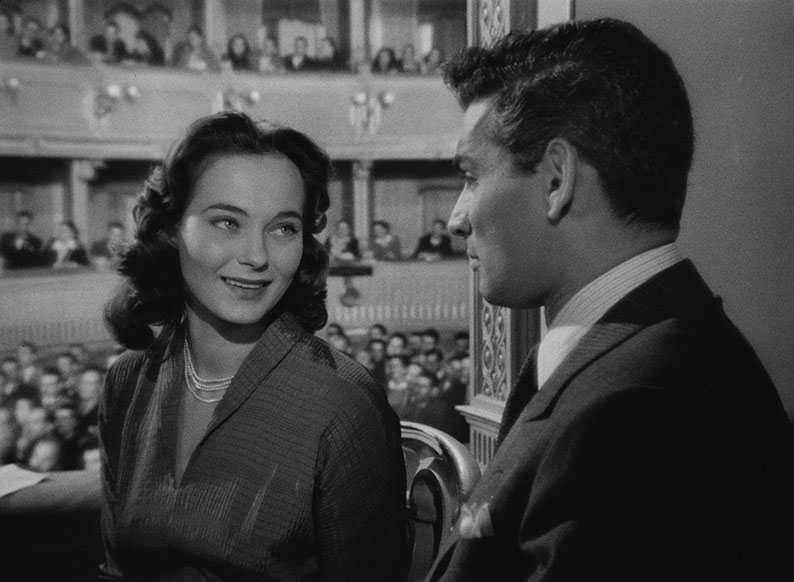
Audio Commentary with Daniel Kremer
Filmmaker and film historian Daniel Kremer provides background details on the making of a film that he notes early on is particularly distinguished by its Italian location work. Info is delivered on director Robert Siodmak, cinematographer William H. Daniels, art director Nathan Juran, and particularly several of the cast, including John Mhyers, who appears in a small role as a French customs officer but is not credited anywhere for it, including on IMDb. Links are made to several relevant films and the real-life gangster, Charles 'Lucky' Luciano, other Hollywood films shot in Italy during this period are touched upon, and the film's various early working titles are discussed. Kremer isn't the liveliest of orators and I did find my attention wandering occasionally towards the end, but I still learned a fair amount from this.
Return to Europe: Christina Newland on Robert Siodmak (10:28)
Film critic and a writer on various Hollywood histories Christina Newland looks at the career of director Robert Siodmak, with specific focus on Deported, his final noir film for Universal. It's a film she describes as a mixed bag of neorealism and stylised noir, but an interesting time capsule nonetheless (I'm absolutely with her on this), and she does provide some useful background details on the aforementioned 'Lucky' Luciano.
Image Gallery
19 screen of promotional stills and posters.
A Salute to France (1944) (34:54)
A promotional film made by the Office of War Information on the wartime alliances of the French, British and American nations, co-directed by Garson Kanin and Jean Renoir, and starring Burgess Meredith, Philip Bourneuf, and Deported's Claude Dauphin as American Joe, Englishman Tommy and Frenchman Jacques respectively. During the course of the film they represent a variety of everyman citizens of each country, the aim being to show that despite differences in the locations of our birth, we have more common with each other than those who seek to divide us might suggest. Frankly, it's a message still worth shouting from the rooftops. Beautifully structured from a script by Philip Dunne, Burgess Meredith and Jean Renoir, it's a genuinely remarkable work on all fronts, really well assembled and challenging up front that still-bandied claim that France too quickly folded in the face of Nazi aggression, as well as saluting the Frenchmen who continued to fight against the occupying force, regardless of their own safety. Full marks to Indicator for the inclusion of this rarely seen wartime propaganda gem.
NAKED ALIBI
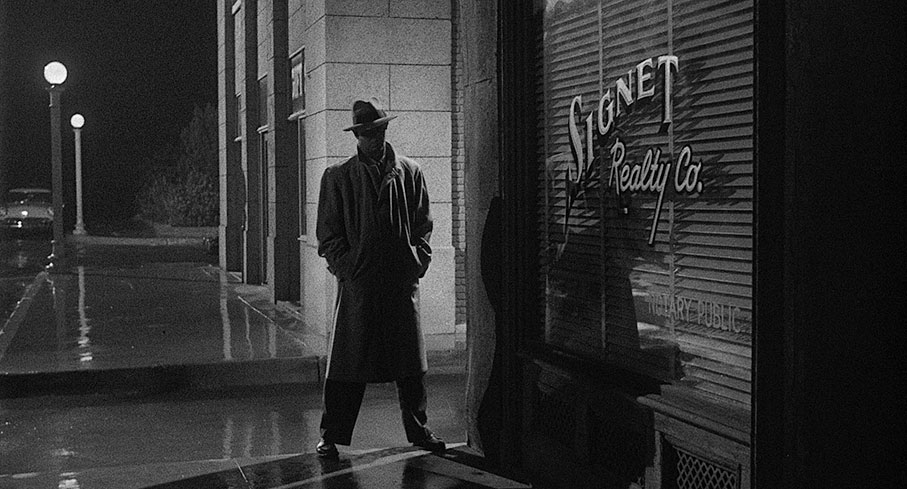
Audio Commentary with Troy Howarth and Nathaniel Thompson
Mondo Digital's Nathaniel Thompson teams up with Troy Howarth, a writer who specialises in European cult cinema, for another lively and enthusiastic commentary full of useful information and interesting opinion on the film. Details on director Jerry Hopper, cinematographer Russell Metty, art director Alexander Golitzen and the lead actors are provided, with particular emphasis Sterling Hayden and Gloria Grahame. They note the similarities to aspects of both The Big Heat and Dirty Harry, discuss the studio system and how it changed, and describe Naked Alibi as a good mid-tier noir rather than a top-tier one. They also express their hope that Indicator will release some of Jack Arnold's noir work for Universal in later volumes of this series. Watch this space.
Absolute Magnetism: Lucy Bolton on Gloria Grahame (41:50)
Film historian Lucy Bolton delivers a most engaging and impressively in-depth review of the film work of Gloria Grahame, from her defining role in Frank Capra's It's a Wonderful Life through a string of memorable roles in key films of the 1940s and 50s to her work on Naked Alibi and subsequent films. Her roles in each of the more notable movies are given impressive coverage, with her musical introduction in Naked Alibi deconstructed in fascinating and persuasive detail.
Theatrical Trailer (2:17)
There are spoilers aplenty in a trailer that is curiously missing one crucial thing – its graphics. At no point is the title shown or announced by the narrator. It's in good shape, though.
Image Gallery
49 screens of monochrome publicity stills, horribly coloured lobby cards, showman's manual pages and poster.
The Cinematographer (1951) (9:31)
A documentary short directed by Jerry Hopper, produced by the Academy of Motion Picture Arts and Sciences, that provides a useful insight into the role of the director of photography on feature films. Features plenty of staged but still authentic-looking behind-the-scenes footage, and a variety of illustrative film clips, a fair few of which you should recognise.
Also included is a Limited Edition 120-Page Book, which includes credits for all six films and essays and further articles on each. The Web is tackled by curator and writer Iris Veysey, who delivers a nicely observed overview of the film, its director and its cast, which is followed by extracts from an interview with director Michael Gordon, conducted in 1982 and 1983 but published posthumously in 2005. Gordon here talks about his early days in theatre, becoming a movie director and his first response to receiving the script for The Web. Writer and researcher Jill Blake delivers a concise appreciation of Larceny, which is partnered with some intriguing snippets from gossip column articles of the day about actor Shelley Winters. Author and editor-in-chief of the film noir bi-monthly Dark Pages, Karen Burroughs Hannsberry, gets her analytical teeth into Kiss the Blood Off My Hands, identifying the noir tropes that are turned on their head and discussing the issues created by the no-nonsense title. After this are extracts from articles from a North Hollywood Valley Times from 1948 and an Arizona Republic piece from 1956 on Burt Lancaster, both of which feature interviews with the actor. Freelance writer Sabina Stent notes the blurring of the lines between the semi-documentary and noir elements of Abandoned, as well as discussing the emotional impact of the true-life criminal activity at its core. It's this that is the focus of the extracts from newspaper articles the film's publicity material that follow, which confirm the cooperation the filmmakers received from the Salvation Army. The influence of real-life gangster 'Lucky' Luciano on the lead character of Deported is explored by editor and reviewer Sergio Angelini, who savvily describes the film as "part noir, part travelogue, and part romantic melodrama," one whose strengths and weaknesses he discusses with pleasing directness. A 1950 piece by M. Oakley Stafford from the Hartford Courant follows, reporting from the Italian location shoot of the film and rounding off by talking about Jeff Chandler's 'up in the clouds' six-foot four-inch physique. Walter Chaw, senior critic for FilmFreakCentral, pays tribute to Sterling Hayden and Gloria Grahame in his essay on Naked Alibi, whose performance of the song 'Ace in the Hole' is the subject of a 1954 piece by Bob Thomas from the Springfield Daily News and a later piece from the Lansing State Journal. Tailing this is an article from the Battle Creek Enquirer about Gloria Grahame's stand-in, Peggy Burke, who in an unusual step was sent by Universal to promote the film instead of Grahame. The book concludes with the main credits and short articles on all of the included short films, and as ever, is illustrated with stills and publicity materials.
I love writing about films but my current health issues have made a battle out of what should have been a joy, which you should not take as a reflection of the quality of this excellent set. This is another welcome release from Indicator featuring several titles that have effectively been off the radar for years, and while you might question the noir credentials of some of them, all have enough noir elements to justify their inclusion here. The special features are also really impressive here, from the archive shorts to that glorious interview with Joan Fontaine. Once again, a must for genre fans, and the first of what we all hope will be a series of Universal Noir releases from this label. Highly recommended.
<< Part 1: The Films
|